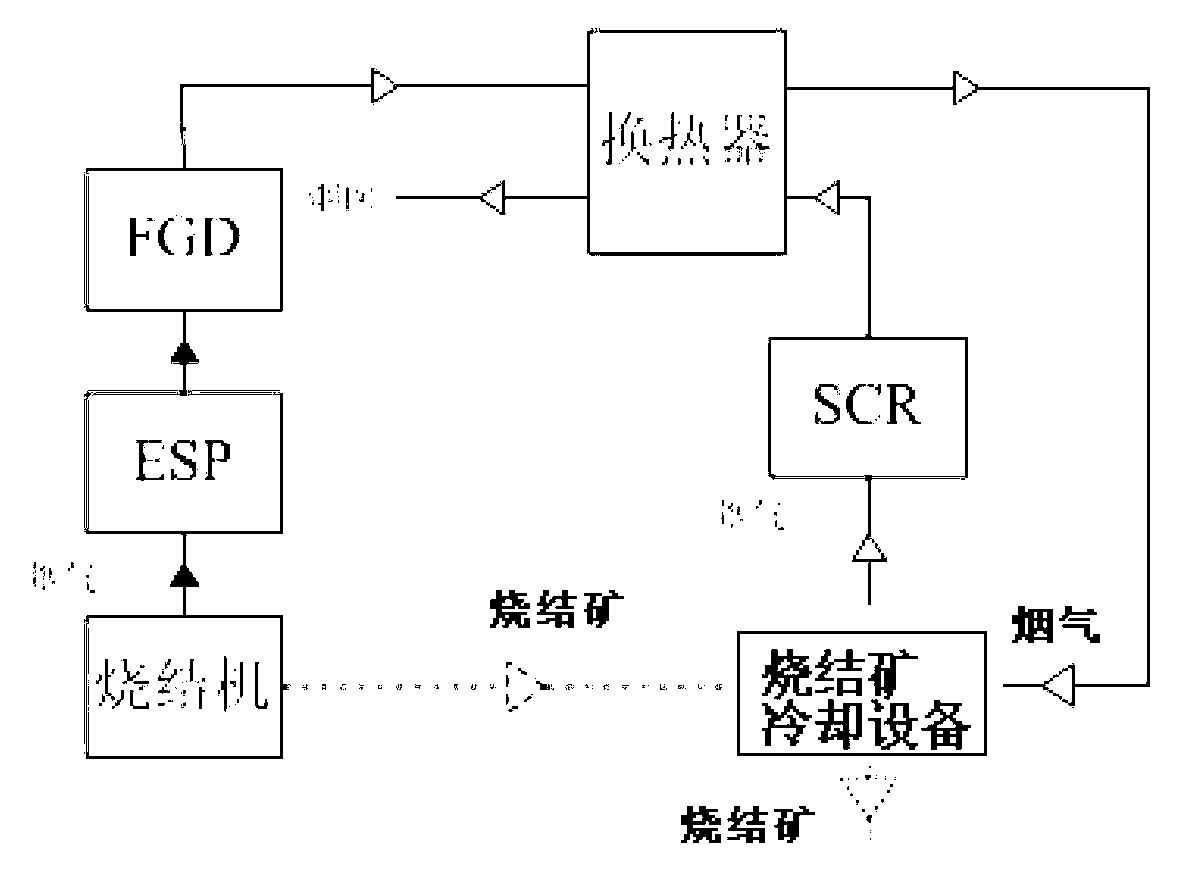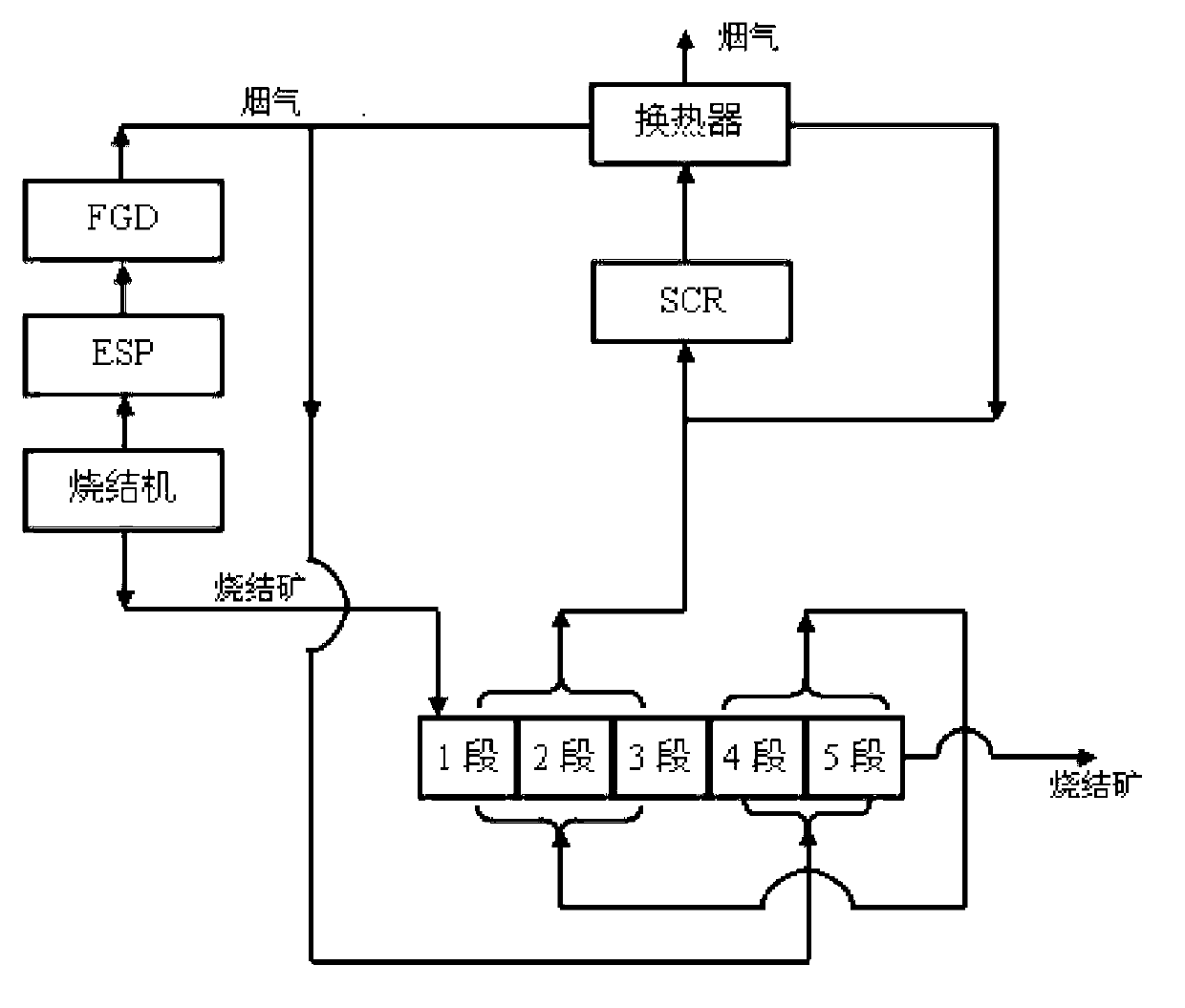Sinter waste-heat utilization process based on purification of sintering flue gas
A technology for sintering flue gas and sintering ore, which is applied in the field of sintering ore waste heat utilization process based on sintering flue gas purification, can solve the problems of "ammonia escape and the continuity of sintering ore waste heat recovery heat source is difficult to ensure, etc., to improve the utilization rate, easy to The effect of simple operation and process flow
- Summary
- Abstract
- Description
- Claims
- Application Information
AI Technical Summary
Problems solved by technology
Method used
Image
Examples
Embodiment 1
[0036] Example 1 (see figure 1 ):
[0037] The flue gas and sintered ore are drawn out from the sintering machine, and the flue gas is desulfurized at 50-60°C after being subjected to electrostatic precipitator (ESP) and ammonia desulfurization. Indirect heat exchange Pre-heating to 190-230°C, and then direct heat exchange with sintering ore at 800-900°C from the sintering machine in the sinter cooling equipment, after heat exchange, the temperature of desulfurization flue gas above 380°C (tested nitrogen Oxide content higher than 300mg / m 3 ) to obtain purified flue gas after denitrification by SCR method, and the purified flue gas is further exchanged with the above-mentioned desulfurized flue gas in the above-mentioned heat exchanger and cooled to 100-120°C before being discharged. The sintered ore is sent to the next process.
[0038] In this example, after testing, the concentrations of sulfur dioxide and nitrogen oxides in the purified flue gas meet the "Steel Sinterin...
Embodiment 2
[0039] Example 2 (see image 3 ):
[0040] Wherein, the sinter cooling equipment in this embodiment is an annular cooler, and the annular cooler is divided into 5 sections, see figure 2 , from 1st stage to 5th stage, the sinter temperature gradually decreases, 1st stage, 2nd stage and 3rd stage are high temperature stage, 4-5 stage is low temperature stage.
[0041] The flue gas and sintered ore drawn from the sintering machine are subjected to dust removal (ESP method electric dust removal) and ammonia desulfurization to obtain desulfurized flue gas at 50-60°C. The desulfurized flue gas is divided into two streams, and the first stream is desulfurized The flue gas (accounting for 65-85% by volume of the total desulfurization flue gas) is sent to the low-temperature section (sections 4 and 5) of the annular cooler for a heat exchange with the sinter located in the low-temperature section to raise the temperature, and then sent to the annular cooler. The high-temperature sec...
Embodiment 3
[0043] Embodiment 3 (see image 3 ):
[0044] Among them, the sinter cooling equipment in this embodiment is a tower cooling equipment (such as the "vertical closed tank" disclosed in 200910187381.8)
[0045] The flue gas and sintered ore are drawn out from the sintering machine, and the flue gas is subjected to dust removal (ESP method electric dust removal) and ammonia desulfurization to obtain desulfurized flue gas at 50-60°C. The desulfurized flue gas is divided into two streams, the first desulfurized flue gas Gas (accounting for 65-85% by volume of the total desulfurization flue gas) is sent to the tower cooling equipment to directly exchange heat with the sinter to 430-470°C; The intermediate indirect heat exchange raises the temperature to 190-230°C, and then mixes with the first desulfurization flue gas from the tower cooling equipment to make the flue gas (the nitrogen oxide content is higher than 300mg / m 3 ) when the temperature reaches above 380°C, SCR denitrific...
PUM
 Login to View More
Login to View More Abstract
Description
Claims
Application Information
 Login to View More
Login to View More - R&D
- Intellectual Property
- Life Sciences
- Materials
- Tech Scout
- Unparalleled Data Quality
- Higher Quality Content
- 60% Fewer Hallucinations
Browse by: Latest US Patents, China's latest patents, Technical Efficacy Thesaurus, Application Domain, Technology Topic, Popular Technical Reports.
© 2025 PatSnap. All rights reserved.Legal|Privacy policy|Modern Slavery Act Transparency Statement|Sitemap|About US| Contact US: help@patsnap.com



